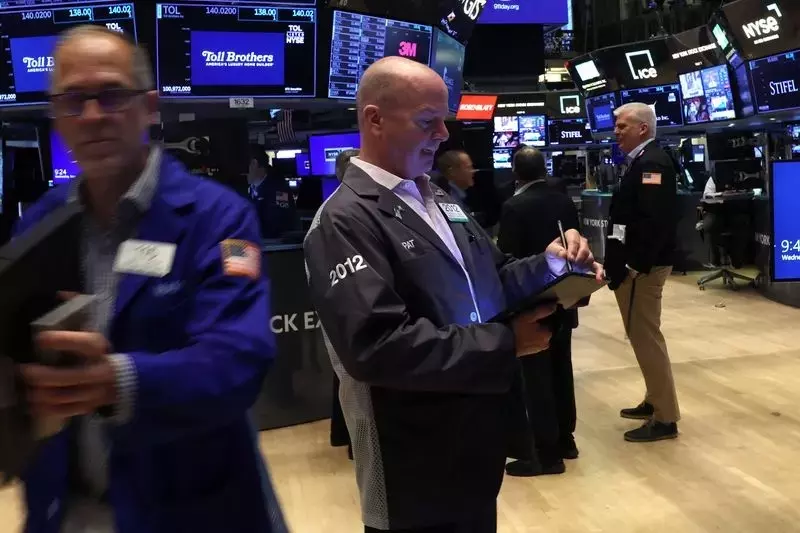Wall Street Rallies as Retail Sales Defy Slowdown Fears
Wall Street's main indexes surged on Tuesday, with the benchmark S&P 500 nearing its intraday record high, as investors eagerly awaited a crucial Federal Reserve policy decision and fresh economic data that allayed concerns about a sharp slowdown in the U.S. economy.Defying Expectations, Retail Sales Shine Bright
Resilient Consumer Spending Fuels Market Optimism
A Commerce Department report revealed an unexpected rise in retail sales in August, as a decline in auto dealership receipts was offset by a surge in online purchases. This data suggests the U.S. economy remained on solid footing through much of the third quarter, contrary to fears of a significant slowdown.The resilience of consumer spending, a crucial driver of economic growth, has been a source of optimism for investors. Despite concerns about rising inflation and interest rates, American consumers have continued to open their wallets, bolstering the overall economic outlook.Tech Titans Lead the Charge
The market's gains were led by rate-sensitive growth stocks, such as Alphabet and Tesla, which rose 1.0% and 1.90%, respectively. Nvidia also edged up 0.44%, pushing the broader chips index higher by 0.60%.Microsoft, the AI-frontrunner, was a standout performer, boosting the S&P 500 with a 2.3% surge on the day. The tech giant's board approved a new $60-billion share buyback program and hiked its quarterly dividend by 10%, further fueling investor enthusiasm.The broader tech sector climbed 0.70%, reflecting the market's confidence in the industry's ability to weather economic headwinds and continue driving innovation.Small Caps Shine in Low-Rate Environment
The blue-chip Dow Jones Industrial Average traded at a record high, while the Russell 2000 index, which tracks small-cap stocks, advanced 0.71%. Small-cap companies tend to perform better in a low-interest-rate environment, as they often rely more on debt financing to fuel their growth.The outperformance of small-cap stocks suggests that investors are anticipating a more accommodative monetary policy from the Federal Reserve, which could provide a tailwind for these companies.Sectors Diverge, but Optimism Prevails
Seven of the 11 S&P 500 sectors traded higher, led by a 1% rise in Consumer Discretionary stocks. This sector's strength underscores the resilience of consumer spending, as Americans continue to allocate their discretionary income despite economic uncertainties.While the market's performance was not uniform across all sectors, the overall positive sentiment reflects a growing belief that the U.S. economy may be able to navigate the challenges it faces without a sharp slowdown.Investors Await Fed's Next Move
As the Federal Reserve's two-day policy meeting commences, traders are betting on a 65% probability that the central bank will decide to lower borrowing costs by a more substantial 50 basis points. This represents a shift from the previous week, when the odds favored a smaller 25-basis-point reduction.Investors are closely monitoring the Fed's remarks and policy decisions, as they will have a significant impact on the direction of the market. The central bank's actions will be crucial in determining whether the economy can achieve a "soft landing" – a delicate balance between taming inflation and maintaining growth.September Surprise: Bucking Historical Trends
Historically, September has been a weak month for U.S. equities, with the benchmark S&P 500 down about 1.20% on average since 1928. However, factoring in the day's gains, the index is currently up approximately 0.20% so far this September.This deviation from the typical September slump suggests that investors are cautiously optimistic about the market's prospects, despite the lingering economic uncertainties. The resilience of consumer spending and the potential for a more accommodative monetary policy have bolstered investor confidence, at least in the short term.Global Sentiment Shifts Toward Optimism
A survey of BofA fund managers revealed that global investor sentiment improved in September 2024 for the first time since June. This shift in sentiment is driven by optimism around the prospect of a "soft landing" for the U.S. economy and the potential for rate cuts by the Federal Reserve.The improved global sentiment underscores the interconnected nature of financial markets and the importance of central bank policies in shaping investor perceptions. As the world's most influential central bank, the Fed's actions will continue to be closely watched by investors around the globe.

